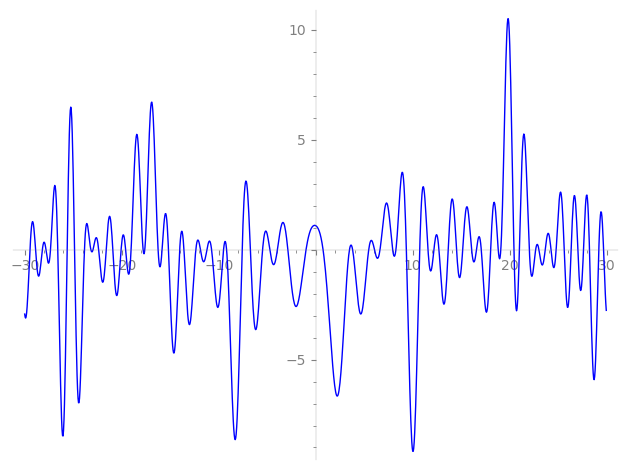| L(s) = 1 | + (0.687 − 1.23i)2-s + (−1.40 + 0.809i)3-s + (−1.05 − 1.69i)4-s − 2.10·5-s + (0.0358 + 2.28i)6-s + (−0.866 − 0.5i)7-s + (−2.82 + 0.132i)8-s + (−0.190 + 0.330i)9-s + (−1.44 + 2.59i)10-s + (2.17 + 3.76i)11-s + (2.85 + 1.52i)12-s + (3.28 + 1.49i)13-s + (−1.21 + 0.726i)14-s + (2.94 − 1.70i)15-s + (−1.77 + 3.58i)16-s + (2.81 − 4.87i)17-s + ⋯ |
| L(s) = 1 | + (0.486 − 0.873i)2-s + (−0.809 + 0.467i)3-s + (−0.526 − 0.849i)4-s − 0.940·5-s + (0.0146 + 0.934i)6-s + (−0.327 − 0.188i)7-s + (−0.998 + 0.0469i)8-s + (−0.0636 + 0.110i)9-s + (−0.457 + 0.821i)10-s + (0.655 + 1.13i)11-s + (0.823 + 0.441i)12-s + (0.909 + 0.414i)13-s + (−0.324 + 0.194i)14-s + (0.760 − 0.439i)15-s + (−0.444 + 0.895i)16-s + (0.682 − 1.18i)17-s + ⋯ |
Λ(s)=(=(728s/2ΓC(s)L(s)(0.923+0.383i)Λ(2−s)
Λ(s)=(=(728s/2ΓC(s+1/2)L(s)(0.923+0.383i)Λ(1−s)
| Degree: |
2 |
| Conductor: |
728
= 23⋅7⋅13
|
| Sign: |
0.923+0.383i
|
| Analytic conductor: |
5.81310 |
| Root analytic conductor: |
2.41103 |
| Motivic weight: |
1 |
| Rational: |
no |
| Arithmetic: |
yes |
| Character: |
χ728(309,⋅)
|
| Primitive: |
yes
|
| Self-dual: |
no
|
| Analytic rank: |
0
|
| Selberg data: |
(2, 728, ( :1/2), 0.923+0.383i)
|
Particular Values
| L(1) |
≈ |
1.06491−0.212346i |
| L(21) |
≈ |
1.06491−0.212346i |
| L(23) |
|
not available |
| L(1) |
|
not available |
L(s)=p∏Fp(p−s)−1 | p | Fp(T) |
|---|
| bad | 2 | 1+(−0.687+1.23i)T |
| 7 | 1+(0.866+0.5i)T |
| 13 | 1+(−3.28−1.49i)T |
| good | 3 | 1+(1.40−0.809i)T+(1.5−2.59i)T2 |
| 5 | 1+2.10T+5T2 |
| 11 | 1+(−2.17−3.76i)T+(−5.5+9.52i)T2 |
| 17 | 1+(−2.81+4.87i)T+(−8.5−14.7i)T2 |
| 19 | 1+(−4.13+7.16i)T+(−9.5−16.4i)T2 |
| 23 | 1+(−3.04−5.26i)T+(−11.5+19.9i)T2 |
| 29 | 1+(−1.05+0.609i)T+(14.5−25.1i)T2 |
| 31 | 1−7.58iT−31T2 |
| 37 | 1+(1.96+3.40i)T+(−18.5+32.0i)T2 |
| 41 | 1+(−3.53+2.04i)T+(20.5−35.5i)T2 |
| 43 | 1+(−7.82−4.52i)T+(21.5+37.2i)T2 |
| 47 | 1−4.60iT−47T2 |
| 53 | 1−7.82iT−53T2 |
| 59 | 1+(3.60−6.23i)T+(−29.5−51.0i)T2 |
| 61 | 1+(−2.27−1.31i)T+(30.5+52.8i)T2 |
| 67 | 1+(−0.990−1.71i)T+(−33.5+58.0i)T2 |
| 71 | 1+(−6.74−3.89i)T+(35.5+61.4i)T2 |
| 73 | 1+4.30iT−73T2 |
| 79 | 1−13.4T+79T2 |
| 83 | 1−17.6T+83T2 |
| 89 | 1+(3.71−2.14i)T+(44.5−77.0i)T2 |
| 97 | 1+(4.53+2.61i)T+(48.5+84.0i)T2 |
| show more | |
| show less | |
L(s)=p∏ j=1∏2(1−αj,pp−s)−1
Imaginary part of the first few zeros on the critical line
−10.73648082825423416783643421447, −9.499530262607997576727409947995, −9.190371333166727499430666269064, −7.58350925118248985119230665949, −6.73557253543694378350327536474, −5.47614549781422740246415183479, −4.73384599514280157587526083629, −3.94794527682078830460641266474, −2.87313756505631227165150667034, −0.996533975007250013832133228443,
0.75371344320994192464180976210, 3.48136353320549791070632837452, 3.79947716929888785185269443363, 5.46565026989535750450445851466, 6.05367815905199268342621579702, 6.62882058390445998477612007350, 7.927026571353798390885645364917, 8.267619581235223800324750961037, 9.340757849669520238298144282056, 10.71809018853225300408064578181

